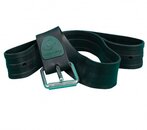You put your weight where you need it. I use a 20 lb weight belt in Seattle -- used to use the webbing type, but Dumpster Diver convinced me that the rubber freediving belts were better. I like not having all my weight on my rig, because for one thing, it makes the rig easier to move around on land, and for another, I don't hang all the weight from my shoulders, which makes walking in my gear easier.
There is a prejudice in technical diving circles against any weight which can be lost, and it is a reasonable prejudice, since loss of significant weight is a really bad thing under a ceiling. But especially in very cold water, IF you are going to weight yourself correctly (which means able to hold a shallow stop with empty tanks) it may not even be possible to put all the necessary weight on the plate.
One of the things I would recommend doing with a dry suit is periodically soaking the exhaust valve overnight in fresh water, and also using a hose to put some water through the valve from inside out. The floppy diaphragms in those valves can get sticky with marine goo and not dump well. If you are going to use the suit a lot, it's not a bad idea to have the o-rings for the inflator valve in your save-a-dive kit, as those valves are prone to leakage with heavy use as well.
Also invest in a set of clamps (homemade works fine) or the lazy man's equivalent, which is plastic bottles of the right size to obturate your neck and wrist seals, and a good spray bottle with dilute detergent in it. If you have a dry suit, it will eventually be a wet suit . . . and being able to find and fix small leaks keeps your suit in your hands and in the water more often!
There is a prejudice in technical diving circles against any weight which can be lost, and it is a reasonable prejudice, since loss of significant weight is a really bad thing under a ceiling. But especially in very cold water, IF you are going to weight yourself correctly (which means able to hold a shallow stop with empty tanks) it may not even be possible to put all the necessary weight on the plate.
One of the things I would recommend doing with a dry suit is periodically soaking the exhaust valve overnight in fresh water, and also using a hose to put some water through the valve from inside out. The floppy diaphragms in those valves can get sticky with marine goo and not dump well. If you are going to use the suit a lot, it's not a bad idea to have the o-rings for the inflator valve in your save-a-dive kit, as those valves are prone to leakage with heavy use as well.
Also invest in a set of clamps (homemade works fine) or the lazy man's equivalent, which is plastic bottles of the right size to obturate your neck and wrist seals, and a good spray bottle with dilute detergent in it. If you have a dry suit, it will eventually be a wet suit . . . and being able to find and fix small leaks keeps your suit in your hands and in the water more often!





